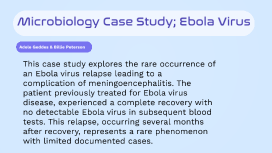Microbiology Case Study
Transcript: Disease Process Techniques used to identify the pathogen PCR (Polymerase Chain Reaction) detects pathogens, including Viral Ebola RNA 3 days after symptoms (Bettini et al., 2023). It amplifies viral genetic material, allowing detection of even minute amounts of viral nucleic acids. This high sensitivity makes PCR a valuable tool for diagnosing viral infections, especially when rapid detection is essential. PCR is not culture-based (Jacobs et al., 2016; Banks et al., 2005). Viral Culture Ebola virus targets liver, spleen, and CNS, causing severe symptoms like headaches, stiffness, and altered consciousness. Confirmatory tests reveal high Ebola virus RNA in CSF, indicating CNS involvement (Sadgir et al., 2023). Imaging shows abnormal leptomeningeal enhancement. Case study demonstrates viral interaction with the host immune response, causing tissue damage. Ongoing symptoms during recovery suggest persistent immune activation. Virus evades immune surveillance, contributing to prolonged illness (Dando et al., 2014; Jacob et al., 2020). As the name suggests, is a culture-based technique employed to confirm the presence of live virus in clinical samples such as cerebrospinal fluid (CSF) or tissue specimens. This technique entails the propagation of viruses in cell culture systems under controlled laboratory conditions. By introducing the clinical sample onto susceptible cell cultures, researchers can observe viral replication and assess cytopathic effects, confirming the presence of the virus (Ghose et al., 2019). Description of Ebola virus 1 The Ebola virus is part of the Filoviridae family and Ebolavirus genus 2 It has a unique filamentous structure surrounded by a lipid membrane. Its genetic makeup includes a single-stranded RNA genome that encodes essential cell entry proteins. 3 Strict containment measures are vital due to this virus's high pathogenicity, usually in biosafety labs. 4 5 Specialised facilities use primate or human cell lines for cultivating the virus for research and potential treatments. (Bharat et al., 2012) Treatment Recommendation Microbiology Case Study; Ebola Virus Adele Geddes & Billie Peterson This case study explores the rare occurrence of an Ebola virus relapse leading to a complication of meningoencephalitis. The patient previously treated for Ebola virus disease, experienced a complete recovery with no detectable Ebola virus in subsequent blood tests. This relapse, occurring several months after recovery, represents a rare phenomenon with limited documented cases. Case Presentation Pauline Cafferkey, a 39-year-old female nurse from Scotland, contracted Ebola while caring for patients in Sierra Leone in 2014. Diagnosed upon her return to Glasgow, she experienced symptoms including severe respiratory distress, mucositis, erythroderma, and diarrhoea. There she received various therapies, including intravenous fluids, and antibody treatments, and was discharged after 28 days. However, she faced complications such as, thyrotoxicosis, hair loss, and bilateral joint pain and swelling. 9 months after the initial discharge she experienced a relapse, characterised by severe headaches, fever, and neurological symptoms, requiring urgent medical intervention and antiviral therapy (Jacobs et al., 2016). Ebola treatment involved supportive care, drug therapy, and monoclonal antibody treatment with some adverse reactions. GS-5734 and high-dose steroids were used, but their impact on the disease course remains uncertain. Anamnestic antibody response was detected, and ongoing vigilance in Ebola survivors is crucial for global response (Jacobs et al., 2016). Thanking, maybe little conclusion idk References Alhajj, M., Farhana, A., & Zubair, M. (2023, April 23). Enzyme Linked Immunosorbent Assay (ELISA). PubMed; StatPearls Publishing. https://www.ncbi.nlm.nih.gov/books/NBK555922/ Aryal, S. (2018, June 12). Structure of Ebola Virus. Microbiology Info.com. https://microbiologyinfo.com/structure-of-ebola-virus/ Banks, J. T., Bharara, S., Tubbs, R. S., Wolff, C. L., Gillespie, G. Y., Markert, J. M., & Blount, J. P. (2005). Polymerase Chain Reaction for the Rapid Detection of Cerebrospinal Fluid Shunt or Ventriculostomy Infections. Neurosurgery, 57(6), 1237–1243. https://doi.org/10.1227/01.neu.0000186038.98817.72 Baron, E. J. (2013). Classification. Nih.gov; University of Texas Medical Branch at Galveston. https://www.ncbi.nlm.nih.gov/books/NBK8406 Bharat, T. A., Noda, T., Riches, J. D., Kraehling, V., Kolesnikova, L., Becker, S., Kawaoka, Y., & Briggs, J. A. (2012). Structural dissection of Ebola virus and its assembly determinants using cryo-electron tomography. Proceedings of the National Academy of Sciences of the United States of America, 109(11), 4275–4280. https://doi.org/10.1073/pnas.1120453109 Dando, S. J., Mackay-Sim, A., Norton, R., Currie, B. J., St. John, J. A., Ekberg, J. A. K., Batzloff, M., Ulett, G. C., & Beacham, I. R. (2014). Pathogens Penetrating the Central Nervous System: Infection

















